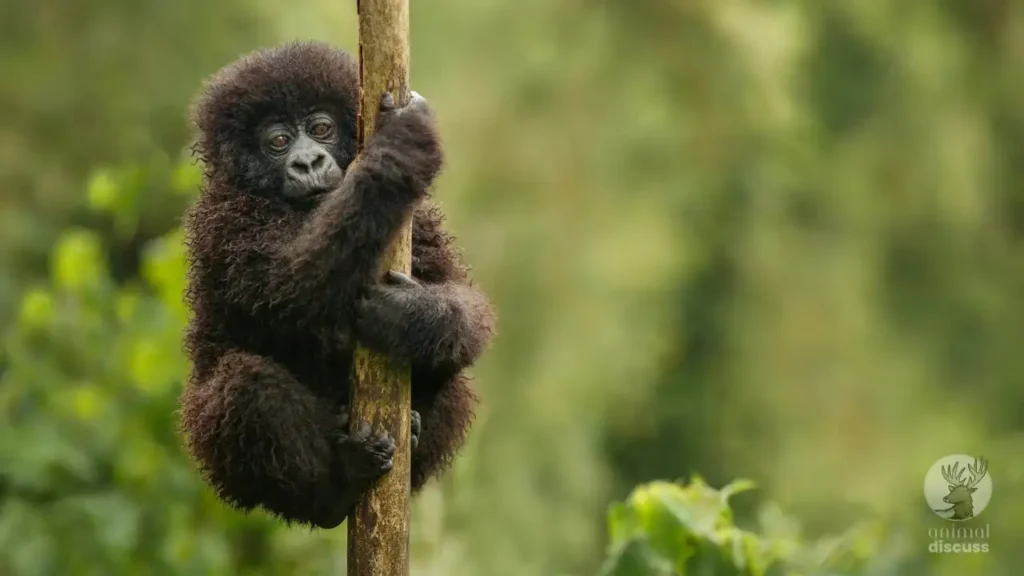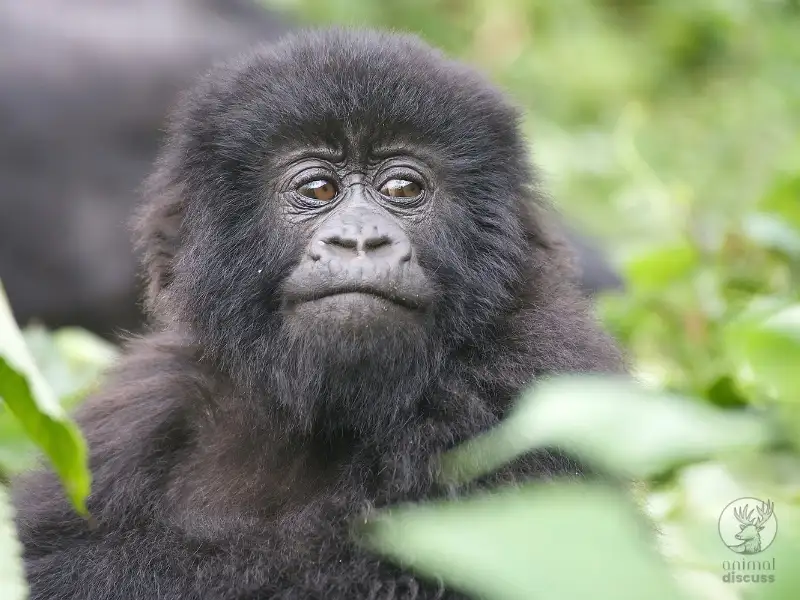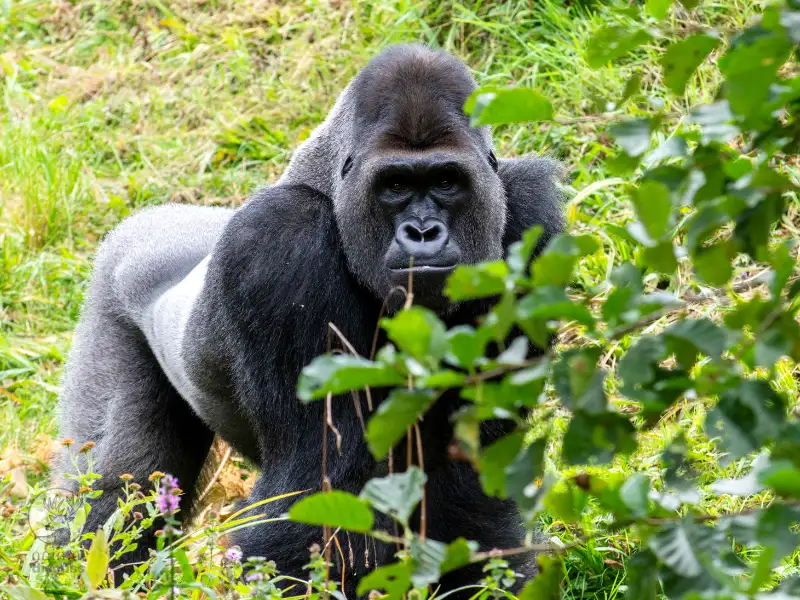How much do you know about Gorillas? Most of us have heard that Gorillas show high similarity at the genetic level to humans, right?
They are the largest living primates. Gorillas have stocky bodies and are well-covered with dark hair. They are distinguished by their strong body, high brow ridges, and strong arms. Males are bigger and more intimidating than females.
In this article, I have mentioned Gorillas inhabiting, their features, behavioral facts, notable types, and their eating habits. I have also discussed Gorillas’ reproductive and conservation strategies. Let’s learn more about them –
Characteristics of Gorillas: How Do They Look Like?
The largest primates, the gorillas, have some distinct features. Gorillas are between 1.5 and 1.7 m tall, and their weight varies between 70-220 kg. They have a tough and muscular body which is usually characterized by their heavy head and small tail. Their coat color is black.

One of the most amazing characteristics of gorillas is that they have a unique walking style known as knuckle-walking. This type of movement involves walking on the four limbs with some of the weight on the knuckles of their hands.
They use their long muscular arms for movement because it is about 15-20 percent longer than their stocky legs.
Let’s have a quick review of their distinctive attributes in the table below.
| Characteristics | Description |
|---|---|
| Common name | Gorilla |
| Scientific name | Gorilla gorilla, Gorilla beringei |
| Family name | Hominidae |
| Number of Species | Two |
| Height | Around 1.5-1.7 meters |
| Weight | Between 70-220 kilograms |
| Coloration | Black fur |
| Head | Wide and robust |
| Tail | Small, minimal |
| Lifespan | 35-40 years |
| Habitat | Tropical and Subtropical forests |
| Diet | Herbivorous |
| Mating Life | Sexual reproduction |
| Communication | Vocalizations, scents, and gestures |
| Conservation status | Critically Endangered |
How Many Types of Gorillas Are Found?
There are two main types of Gorillas: The Eastern Gorilla and the Western Gorilla. Although the two are referred to as Gorillas, they have many differences in their features and the nature of evolution.
Let’s explore them briefly in the table below.
| Eastern Gorilla | Western Gorilla |
|---|---|
| Lives in Mountain rainforests | Found in Lowland Rainforest |
| They have distinct black fur | They have brown to gray fur |
| Weigh between 200-220 kilograms | Weigh Between 160-220 kilograms |
| They are 1.8 meters tall | Their height is up to 1.7 meters |
| Herbivorous | Herbivorous |
However, besides two recognizable types of Gorillas, Eastern Lowland Gorilla, Mountain Gorilla, Western Lowland Gorilla, and Cross River Gorilla are the subspecies of Eastern and Western Gorilla.
Where Do Gorillas Live?
Gorillas live in the tropical lowland and subtropical forest areas of Africa’s equatorial region. They live in Cameroon, Nigeria, the Democratic Republic of Congo, Rwanda, and Uganda, etc.

Besides, Gorillas are found in and from different forest ecosystems. That includes lowland rainforests and mountain regions. Because of the dense vegetation, and facilities for food, shelter, and nesting needs, they inhabit those mentioned areas. You can find Gorillas from sea level to over 4,000 meters in the mountains.
On the other hand, Gorillas don’t migrate. However, the distribution of their habitat within the forest may influence them to migrate. Those factors are elevation, vegetation, and human activity.
Read this article to know more about their habitat in this article “Gorillas Habitat“.
What Are the Behavioral Facts of Gorillas?
Gorillas exist in family groups and males usually become leaders. These groups typically comprise numerous females, their unborn, and reproductive males.
The head Gorilla acts as a defender of the group. As a leader, he organizes daily activities which include foraging, nesting, and so on.
However, Gorillas are not strictly territorial creatures. Still, they defend their territory via scent marking and vocal displays. Male Gorillas intimidate other groups or possible intruders.
They use their scent glands which are highly specialized as a way to mark their territory with urination and feces for that purpose. Gorillas also use chest beating and roaring to show dominance and scare away rival groups from their territory.
Curious to learn about gorilla behavior? Explore this article .
How Do Gorillas Communicate?
Gorillas communicate through a unique combination of vocalizations, gestures, and body postures.
They vocalize many types of sounds, such as groans, husks, barks, roars, and screams. They do so while having stress about boundaries, showing threats, or communicating with others to reinforce social relations.

Apart from that, they also emphasize physical gesturing to pass messages and form a social order. Such gestures generally consist of chest-beating, charging, embracing, and submission signaling.
Again, as I said they have scent glands that they spit out and dark urine and feces to mark their territories, they use this to create a social boundary. It also helps them in terms of gender identity and conveying information about reproductive conditions and social groups.
What Do Gorillas Eat?
Gorillas are primarily herbivores. The main diet of the gorillas includes plant components like leafy shoots, branches, young leaves, and leaves. They consume the stems of different plants such as bamboo and woody vegetation.
Such components contribute to the total nutrients as well as to fiber in their meals. Gorillas also intake fruit wherever available such as berries, figs, and other seasonal fruits. These provide vitamins, minerals, and sugars in required amounts and maintain nutritional balance.
Additionally, they take insects like ants, termites, or grubs. Although it is not the main part of their diet, sometimes gorillas eat insects that can be found in decaying wood or plant litter. Insects also supply a source of protein and fat.
However, gorillas have their digestive systems. It is adapted to break down tough cellulose that forms the main ingredient of plant cell walls.
Curious to learn their dietary habits and hunting strategies? Explore this article “What Do Gorillas Eat? Diet, Eating Habits, and More”.
How Do Gorillas Reproduce?
Gorillas reproduce sexually. Their mating can happen any time of year, just like humans.
Female gorillas go through estrus cycle phases. During that phase, dominant males of their group or a neighboring group, show sexual interest. Complex courtship rituals accompany mating. Males competing for queens are bolder and may show their superiority by acting aggressively.
Following mating, female gorillas go in a gestation phase of about 8.5 months. Then they have a very small baby. However, twins can be produced in some cases, but they are rare.
Likewise, female gorillas engage in long-lasting parental care by carrying the newborns. They also shelter them from predators and rival males. Gorilla infants feed on their mother’s milk and stay with them for four years. But they become more and more independent as they grow up.
What Is the Conversation Status of Gorilla?
According to the IUCN, Gorillas can be grouped under the endangered categories as they face alarming threats in their natural habitat.
The threats include many things, like habitat destruction and degradation. These are caused by deforestation, human invasion, and agricultural land use. Gorillas also undergo poaching for the illegal wildlife trade.
Additionally, transmission of diseases from humans or animals living in domestic areas also causes problems for them.
Conserving gorillas entails both habitat conservation and anti-poaching activities. It requires community-based conservation and scientific research. To get the required data and information on habitat protection, anti-poaching measures, and sustainable management plans we need science.
However, Civil unrest and armed conflicts affect conservation effectiveness. It increases poaching, and habitat destruction due to the local community’s displacement, and limited access to essential resources for conservation activities.
This makes it difficult for conservation organizations to operate safely and efficiently. So, partnerships between conservation organizations, government agencies, local communities, and international partners are necessary to narrow down these problems.
Frequently Asked Questions
Curious to know more about them? the following list of frequently asked questions will provide additional information about Gorillas –
01. How strong is a Gorilla?
Gorillas’ strength is about 10 times their body weight. They are actually 20 times stronger than adult humans.
02. Why is a gorilla called Gorilla?
A gorilla refers to a hairy person. So, because of their appearance, we call them Gorillas.
03. Can a gorilla swim?
Naturally, Gorillas cannot swim. They try to avoid rivers and other water bodies.
04. Is it safe to pet a gorilla?
No, Gorillas are wild animals. It’s not safe to keep them as pets.
05. Can Gorillas eat meat?
As I mentioned earlier, they are herbivores. They don’t have meat normally. Still, in a captive state, they might intake some meat.
Conclusion
In sum, these great apes mainly live in the mountains. Gorillas have unique characteristics among other animals. They have a robust black-haired body.
Gorillas mainly feed on plants. Interestingly, Gorillas have specially developed communication skills, and their sexual behavior resembles humans.
Nonetheless, they are in danger of being hunted, habitat loss, and disease transmission. Efforts using collaboration are needed to avoid their extinction. We must preserve their habitats, control the illegal wildlife trade, and enhance community-based conservation. Then the survival of Gorillas can be ensured.
References
- https://www.britannica.com/animal/Gorilla-primate-genus
- https://nationalzoo.si.edu/animals/western-lowland-gorilla
- https://www.worldwildlife.org/species/gorilla
- https://www.sciencedirect.com/topics/immunology-and-microbiology/gorilla-gorilla
- https://kabiragorillasafaris.com/gorilla-strength
- https://louisvillezoo.org/gorilla-forest/gorilla-facts/
- https://www.ifaw.org/animals/gorillas

